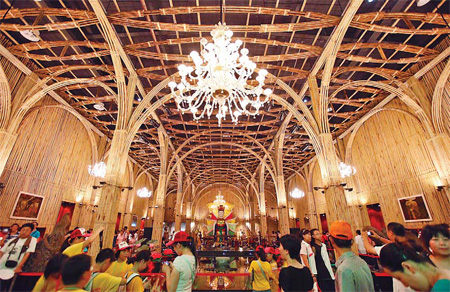Bamboo - a flexible alternative
 |
| The Vietnam Pavilion is made entirely from bamboo. |
Bamboo is not only a highlight of some of China's forests but also an important part of the Expo 2010 Shanghai. National and Urban Best Practices Area (UBPA) pavilions use bamboo in innovative and environmentally friendly ways, encouraging builders and architects to use this fast-growing and readily available crop.
"Bamboo has always been important for rural communities, but for urban consumers it has had something of an image problem," said Coosije Hoogendoorn, general director of the International Network for Bamboo and Rattan (INBAR), at an event held at the India Pavilion in July.
According to research by the INBAR, bamboo helps to protect forests, harbors biodiversity, restores landscapes, fights climate change and supports the livelihoods of more than 1.5 billion of the world's poorest people. It can also help strengthen many developing world economies as it generates more than $5 billion in annual global trade.
Bamboo can grow as fast as half a meter a day and absorbs 20 percent of carbon, preventing soil erosion. It's also the most flexible and sustainable natural material for construction and architecture projects.
Many pavilions featured at the Expo were inspired by the technical innovations that bamboo provides. The Spain, India, Indonesia, Norway, Vietnam, Peru, Madrid and the German-Chinese House pavilions all showcase the enormous potential for modern bamboo constructions.
The India Pavilion has the largest bamboo dome in the world, resembling an upside-down basket. The dome uses 36 bamboo ribs that bend from the base and reach the top of the crown.
"The ribs are connected by 10 bamboo and four steel rings, at different levels to ensure that the bamboo structure was built to the correct geometry on site," said D. R. Naidu, an architect for the India Pavilion. He said that villas, houses and even airport terminals in India had adopted bamboo as a core material.
The Madrid Case Pavilion in the UBPA, is also a bamboo building. The building represents an advanced habitation model that is environmentally friendly using renewable energy and materials.
"The use of bamboo, which helps control temperature and reduce noise, originated from a residential block in southern Madrid," said Manu Rubio, director of the Madrid Case Pavilion. He said that the global bamboo market could see remarkable growth in the next 20 years as the demand for bamboo increases.
As the only Chinese representative at the INBAR forum, Lin Hai, president of the Dasso Industrial Group, one of the leading manufacturers of engineered bamboo flooring and laminate products, introduced how China was using bamboo as a key industry.
"China has used bamboo for thousands of years as a cultural tradition. We're famous for manufacturing exquisite bamboo products. Bamboo entrepreneurs are encouraged by the government to be responsible for creating more sustainable buildings at the moment." said Lin.
The INBAR forum was meant to generate the public's attention about the bamboo industry so that more bamboo products and buildings would be accepted and welcomed by more people around the world.
"There is a perception that bamboo is a poor man's timber, but modern technology now enables bamboo to be used in literally thousands of products with added environmental and social benefits," said Hoogendoorn.
 0
0 






